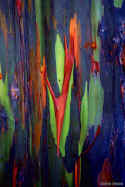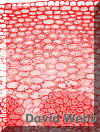Periderm is a secondary tissue produced by the Cork Cambium or Phellogen. Periderm is
a protective tissue. Its cells are called Cork or Phellem. They are dead at maturity but their walls are impregnated
with Suberin. Suberin is a waxy
material like Cutin & it stains positively with Phloroglucinol
& Sudan. Suberin is waterproof
and resists microbial degradation. Consequently, cork cells
protect the stem or root from excess water loss and the entrance of pathogens. It also
acts as an insulator against extreme temperatures. Periderm is commonly called Bark. We
will say more about this term later.

Labeled Image showing the first stage of Periderm
production
|

Eucalyptus Bark
Note the colors of the shedding bark and its underlying cells.
The green color indicates the presence of living chlorenchyma. The red/brown cells of the
bark are dead.

Periderm development in the stem often starts in subepidermal Parenchyma
cells.
The image above is what the Cortex of a typical dicot stem
would look like prior to the initiation of Periderm.

Periclinal divisions in Parenchyma cells of the
outer Cortex are the first indication of Periderm formation.
|